Exploring the Price of Burj Khalifa: A Detailed Insight
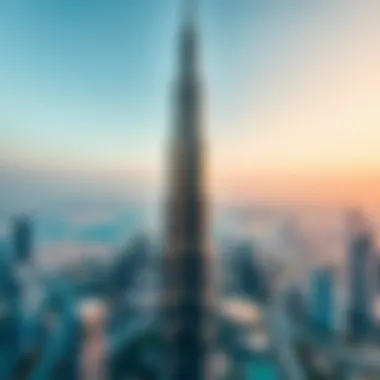
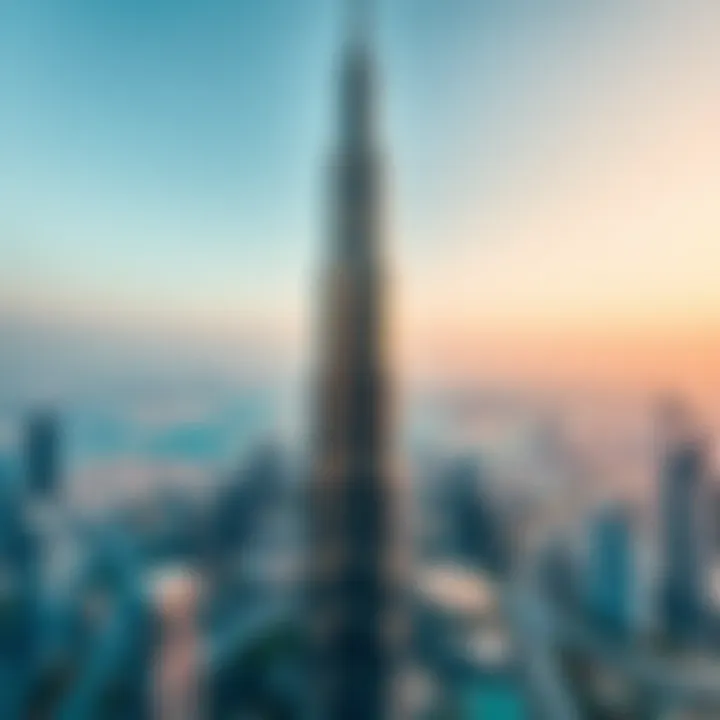
Intro
The Burj Khalifa has become synonymous with luxury and towering ambition. More than just a skyscraper, it’s a feat of engineering that adds a unique note to Dubai's skyline. But beneath the glimmering surface lies a complex financial web that draws both investors and curiosity-seekers. Understanding the price associated with such a monumental structure isn't just academic; it's crucial for those looking to invest in Dubai's competitive real estate market.
This article serves as a compass, guiding you through the various financial layers that envelop the Burj Khalifa. From the hefty construction costs that marked its inception to the evolving property values and commercial leasing prospects today, we will dissect each facet with precision. Moreover, we’ll explore the economic implications for those considering ownership within this iconic piece of architecture. Whether you're an investor, an expatriate, or a real estate agent, the insights provided here will equip you with the knowledge necessary to navigate the heights of this financial landscape.
Market Insights
Current Trends in Dubai Real Estate
Dubai’s real estate market is a tale of two cities. On one side, you have high-end developments that draw the world's elite, and on the other side, you find more residential properties targeted at mid-income earners. Recently, the luxury market, especially around the Burj Khalifa, has witnessed a surge. Reports indicate an uptick in demand for high-end rentals and sales, fueled by a rising expatriate population and increased tourism.
Key trends include:
- A noticeable shift toward sustainability and smart living.
- Increased interest from international buyers, particularly from Asia and Europe.
- Development of mixed-use properties that cater to both luxury demands and community living.
Investors should watch closely as these trends could redefine market dynamics in the near future.
Analysis of Property Prices and Forecasts
When it comes to property values around the Burj Khalifa, there is no shortage of excitement. The area has been known to command some of the highest prices per square foot in the world. Recent listings show that luxury apartments with views of the tower are often priced at a premium, sometimes exceeding AED 4,000 per square foot.
The forecasts suggest a continued appreciation of these prices, albeit at a moderated pace due to various global economic factors. Analysts predict that investments in infrastructure and tourism initiatives will further boost property values in the region.
"Real estate around the Burj Khalifa isn't just an investment; it's a statement."
Investment Guidance
Tips for First-Time Buyers in Dubai
For newcomers looking to dip their toes into Dubai's property market, forged paths can be tricky. Here are some considered strategies:
- Research is vital. Understand the different areas and their unique offerings.
- Engage with local experts. Real estate agents with firsthand experience can introduce you to nuances.
- Discuss financing options. Familiarize yourself with mortgage processes in the UAE, which can differ greatly from other countries.
Key Factors to Consider for Property Investment
Investing is about more than just trends; it’s about understanding underlying fundamentals. Here are a few focal points:
- Location, location, location. Properties in proximity to the Burj Khalifa tend to hold more value and attract buyers.
- Future developments. Promised infrastructure can uplift not just property prices but whole neighborhoods.
- Market timing. It pays to stay updated with fluctuations in the market.
Keeping these tips in mind can help mitigate risk while maximizing potential rewards. Thus, whether eyeing a luxurious penthouse or a commercial lease, being well-informed is the first step to success in this bustling market.
Prelude to Burj Khalifa
The Burj Khalifa stands as not just a structure, but a monumental testament to engineering and architectural prowess in the heart of Dubai. Its towering height and unique design signify more than luxury; they represent Dubai's ambition and vision to be a global player in the real estate market. In the context of this article, understanding the Burj Khalifa means unlocking layers of financial implications, investment opportunities, and economic influences that ripple beyond its floors.
The skyscraper's architecture, which incorporates elements of both Islamic culture and modern design, contributes to its status as a landmark. Its presence reshapes the skyline and draws visitors from all over the world, which in turn, affects property values and market trends in the vicinity. Homebuyers, investors, and even casual tourists can sense the vibrancy that this structure brings to Dubai; it is a beacon that symbolizes prosperity and innovation.
In this section, we will delve into two core aspects: the structure’s intricate design and its role within the wider Dubai environment. By grasping these foundational elements, readers can better appreciate the economic landscape tied to this iconic building, particularly as it pertains to ownership opportunities and financial commitments.
Overview of the Structure
To understand the structure of the Burj Khalifa, one must first recognize its staggering height—standing at 828 meters. It has 163 floors, and each level has been meticulously designed with a specific purpose, from luxury residences to corporate offices and hospitality spaces. The exterior, clad in reflective glass and a unique cladding system, serves not only aesthetic purposes but also practical ones, helping it withstand extreme weather conditions and the Arabian heat.
This building was constructed using over 103,000 square meters of concrete and over 103,000 tons of structural reinforcement. The central core design provides stability and strength, allowing it to sway gently in the wind rather than break. Being the tallest structure in the world comes with challenges, and the Burj Khalifa meets them head-on with innovation and creativity.
Moreover, the layout seamlessly incorporates a mix of spaces. High-end apartments adorn the upper floors, while the premises cater to both high-profile businesses and luxurious hotels below. Such a diverse use of space adds to its allure, making it not just a residential choice but a prime investment area for various stakeholders.
Importance in Dubai's Skyline
The Burj Khalifa isn’t simply part of Dubai’s skyline; it’s its crowning jewel. It reshapes perceptions of what is architecturally possible and has positioned Dubai prominently on the global map. The building has become synonymous with the spirit of the city, drawing millions of tourists and business opportunities each year.
This monumental structure also influences local real estate dynamics profoundly. Properties in its vicinity experience price fluctuations in accordance with its allure. Investors are drawn to the promise of sustainability and growth triggered by the Burj Khalifa, as the area thrives due to increased amenities and infrastructure development.
Moreover, it acts as a catalyst for many ancillary services, from dining experiences to entertainment hubs around it. Each new establishment contributes to an ever-growing community, all orbiting around this iconic tower. The investment potential in this thriving area becomes evident, driving investors to stay hooked on the ongoing trend.
This building is not only an architectural masterpiece but also a pillar of economic growth, attracting global talent and fostering innovation.
As we journey through this exploration of the Burj Khalifa’s price, understanding its structural marvel alongside its impact on Dubai's skyline reveals the deeper layers of opportunity and challenge that lie within this iconic landmark.
Construction Costs of Burj Khalifa
The construction costs of the Burj Khalifa are not just numbers thrown around; they represent an intricate tapestry of engineering brilliance, financial strategy, and macroeconomic factors. Understanding these costs provides valuable insights not only for potential investors but also for anyone interested in the architectural feat that reshaped Dubai's skyline. The impressive height and unique design of the Burj Khalifa brought challenges in materials, labor, and logistics, all of which contributed to its hefty price tag. Exploring these aspects reveals much about what it takes to not only build a skyscraper but to do so in a way that defines a city.
Breakdown of Cost Factors
When we talk about the cost breakdown of the Burj Khalifa, several key factors come into play:
- Material Expenses: The sheer amount of high-quality materials required to support such a massive structure cannot be overstated. Consider this: around 103,000 square meters of glass and a whopping 15,500 tons of structural steel were used, each contributing significantly to the final bill.
- Labor Costs: With over 12,000 workers on-site during peak construction, the labor costs amassed a large chunk of the budget. The expertise required in high-rise construction necessitated skilled professionals, which naturally drives up costs.
- Technological Integration: The use of cutting-edge technology for projects like the Burj Khalifa means that investment in advanced machinery, software, and monitoring systems pushed the overall expenses higher. It isn’t just about constructing; it’s about innovating.
- Logistics and Transportation: Transporting materials to a construction site with such height and complexity isn’t easy. The logistical hurdles involved added layers of costs, considering heavy machinery and tailored transport solutions.
- Regulatory Approvals and Compliance: Obtaining permits and ensuring compliance with local regulations can carry unexpected costs. Every detail matters in construction, especially when it concerns safety—both structurally and from a legal standpoint.
Understanding these factors gives a clearer picture of why the Burj Khalifa was such a significant financial undertaking, providing a foundation upon which future investors can gauge the feasibility of similar projects.
Funding Sources
No structure as grand as the Burj Khalifa can rise without a solid financial foundation. The funding sources behind this architectural masterpiece are as crucial to its story as the materials and labor utilized in its construction.
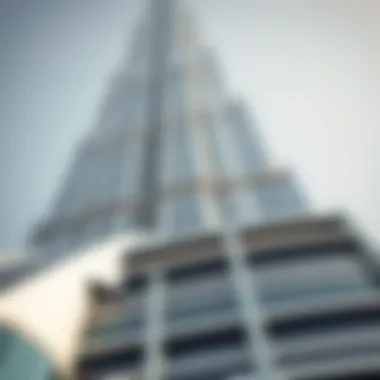
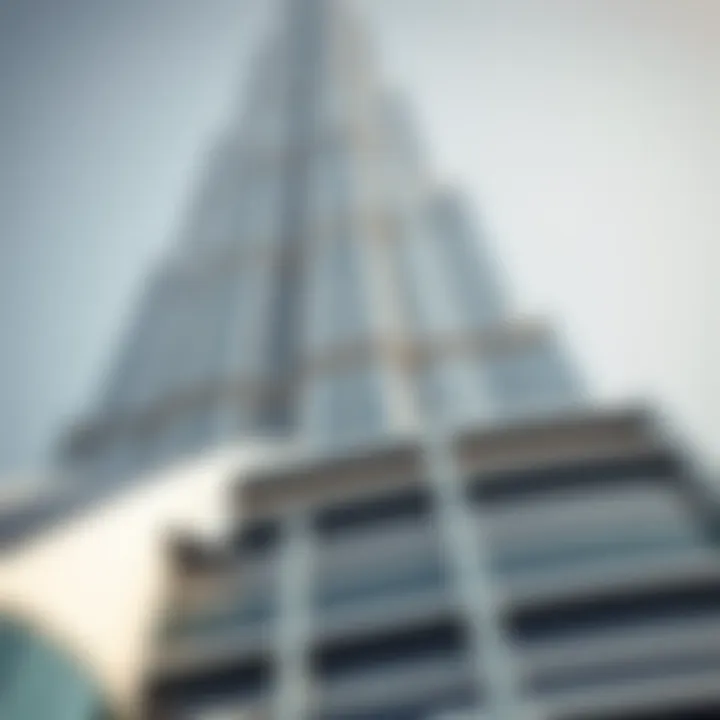
- Private Investment: The principal funding channel for the Burj Khalifa came from private entities, including Emaar Properties, which spearheaded the project. This strategic choice allowed for more flexible decision-making during the construction process, crucial for a project of this magnitude.
- Bank Loans: Bank financing played a significant role in supporting the cash flow. Financial institutions provided loans, helping to bridge the gap between construction expenses and revenue generation from sales and rents once the building was completed.
- Government Support: The Dubai government also contributed indirectly. As part of its broader vision to transform Dubai into a global tourist and business hub, it supported investment initiatives that included infrastructure support and marketing.
- International Investment: Interest from international investors also helped bolster the funding pool. The allure of owning property in one of the world's most striking buildings attracted attention from various markets, generating more financial enthusiasm than could have been achieved through local resources alone.
These funding avenues are more than just monetary—they signify a confidence in Dubai's ability to evolve into a key player on the world stage. This narrative of financial backing reveals the synergy required for not only completing such a project but ensuring its sustainable success.
"The Burj Khalifa is less of a building and more of a beacon of modern ambition."
As investors and enthusiasts explore the financial landscape of the Burj Khalifa, recognizing both the sources of funding and the associated costs is crucial. It underscores the extensive planning and resources needed to bring such dreams to life.
Current Market Value
Understanding the current market value of any property, and especially a landmark like the Burj Khalifa, is pivotal for a myriad of stakeholders, including investors, homeowners, and even tourists. The market value encapsulates not just the price at which one might buy property but also reflects the broader economic health, demand for real estate, and unique characteristics of a locale.
The Burj Khalifa is not just a physical structure; it’s a phenomenon that attracts global attention. Investors are often keen to understand how the price of this tower fluctuates, comprehending both residential and commercial dimensions that contribute to its unique standing in the real estate market. The value is influenced by a multitude of drivers such as location, prestige, economic trends, and the global perception of Dubai as a flourishing metropolis.
Some key considerations include:
- Location: The Burj Khalifa's position in Downtown Dubai makes it a prime asset.
- Historical Significance: As the world’s tallest building, it has a storied history that adds to its allure.
- Current Economic Climate: The ongoing shifts in the real estate market, especially post-pandemic, can affect property valuations.
- Demand Dynamics: The interplay of demand and supply in Dubai plays a crucial role in determining the current market value of properties.
"The Burj Khalifa is not merely about its height; its stature in the market is also about the stories it tells and the experiences it offers."
Residential Property Prices
When discussing residential prices in the Burj Khalifa, one must consider the high-end market segment it caters to. With apartments spanning multiple floors, these residences offer unparalleled views of the city and luxury amenities that are hard to come by elsewhere. Understanding residential property prices here isn't just about the sticker price; it's also about the lifestyle attached to living in such an iconic building.
For those looking to buy, the price can vary significantly depending on the floor and the view. Expect to pay a premium for units higher up. Prices can range from around AED 10,000 to even AED 20,000+ per square foot depending on the specifics. Factors influencing these prices include:
- Location within the Building: Higher floors typically command higher prices.
- Amenities: Access to state-of-the-art gyms, pools, and concierge services adds value to the property.
- Market Trends: The overall performance of Dubai’s real estate market also dictates price shifts.
This overview signals to potential buyers that while the initial investment is significant, the lifestyle and potential returns can be equally rewarding.
Commercial Space Valuation
Turning to commercial space valuation, the Burj Khalifa offers a unique mix. The tower provides spaces that cater to high-profile businesses, meaning that companies drawn to its prestigious address often expect to pay well. Here, valuation hinges on visibility, prestige, and accessibility, making commercial spots in the Burj highly coveted.
Prices for commercial units can soar even higher than residential spaces, frequently exceeding AED 25,000 per square foot depending on the lease terms and location within the building. Key factors influencing commercial valuations include:
- Foot Traffic: The volume of visitors and tourists in the area can enhance business opportunities and, correspondingly, property value.
- Lease Agreements: Long-term leases can stabilize income from commercial spaces, making them attractive to investors.
- Economic Trends: Fluctuating economic conditions might impact the type and number of businesses wanting to occupy space.
In summary, whether discussing residential or commercial properties, the market value pertaining to the Burj Khalifa is dynamic and multi-faceted, influenced by factors that extend beyond simple square footage or physical measurement.
Analyzing Property Demand
Analyzing property demand in the context of the Burj Khalifa is like taking the pulse of a market that is both dynamic and alluring. Demand influences everything from pricing to the types of investments that are likely to yield fruitful returns. Understanding local and international interest levels is crucial for anyone considering buying or leasing properties in this emblematic structure.
One pivotal element in gauging demand is recognizing the uniqueness of the Burj Khalifa. Standing at an incredible height of 828 meters, it’s not just the tallest building; it’s a landmark that draws attention from across the globe. Various factors contribute to demand, making it a nuanced landscape worth exploring.
Buyer Persuasion Factors
When it comes to buyers, there are several key persuasion factors that shape their decisions in the Burj Khalifa arena:
- Prestige: Owning property in such a recognizable icon offers unparalleled prestige. It’s akin to wearing a badge of honor in the real estate sector.
- Tourism Appeal: The property’s close proximity to attractions and world-class amenities boosts its appeal. Tourists flock to its observation decks like bees to honey, presenting opportunities for potential profit if properties are rented out.
- Investment Security: With Dubai’s real estate market being relatively stable compared to other regions, buyers often see properties here as safer bets.
- Luxury Lifestyle: The Burj Khalifa is synonymous with luxury. Buyers aren’t just purchasing a home; they’re buying into a lifestyle that promises exclusivity and sophistication.
These factors negotiate buyers’ decisions, making it not just about square footage but about the essence of living in or owning a piece of a global icon.
Rental Market Insights
Renting out property in the Burj Khalifa provides a unique insight into current market trends. A few noteworthy aspects include:
- Rental Prices: Rental prices in the Burj Khalifa are notably higher than average Dubai properties. This premium price can largely be attributed to its prestigious standing and exceptional facilities. Many tenants are willing to pay a premium, reflecting the desirability that comes with living in a global landmark.
- Demand for Short-Term Rentals: Given its status as a tourist magnet, there’s a significant demand for short-term rentals. Vacation seekers often prefer to stay at such iconic locations, driving higher occupancy rates.
- Diverse Tenant Base: The rentals cater to a diverse mix of expatriates, professionals, and tourists, which creates a stable demand cycle. Each group has different needs, from long-term leases to short stays, and understanding this diversity can help property owners maximize their investments.
- Market Fluctuations: The rental market can be sensitive to economic changes. For instance, global events such as the pandemic had sizable impacts, but recovery trajectories are closely monitored. Keeping an eye on such trends can aid in strategic planning for both potential and current investors.
In summary, understanding property demand associated with the Burj Khalifa isn’t just a transactional concern; it’s about positioning oneself wisely within a competitive and ever-evolving market landscape. These insights can help guide strategic decisions, whether you’re an investor, a homeowner, or a curious onlooker contemplating the beauty of this architectural marvel.
“The Burj Khalifa is not merely a building; it’s a living symbol of ambition and aspiration.”
For further details, consider exploring these resources:
Economic Impact of the Burj Khalifa
The Burj Khalifa serves not just as a breathtaking sight on the Dubai skyline, but it also plays a crucial role in the economic fabric of the city and the broader region. When we talk about the economic impact of this towering icon, it's impossible to overlook how it embodies both visible and hidden advantages. From boosting tourism to fostering local enterprise, the intricacies involved in its economic contribution provide a fertile ground for analysis.
Tourism Contributions
Tourism isn’t just a cherry on top when it comes to the Burj Khalifa; it’s an economic cornerstone. This architectural marvel draws millions of visitors each year, making it one of the most frequented tourist attractions in the world. In 2019 alone, a staggering 1.9 million visitors ascended the observation decks, each contributing to the local economy through ticket purchases, dining, and perhaps even a few souvenirs.
- Multiplier Effect: The flow of tourists supports various sectors, such as hospitality, retail, and transportation. A simple trip to peer out over the city can trigger spending in hotels and restaurants, which indirectly stimulates job creation.
- Brand Recognition: The worldwide recognition of the Burj Khalifa enhances Dubai's reputation as a global tourist destination. This, in turn, allows other attractions in the vicinity to gain much-needed exposure and business opportunities.
Research indicates that tourist spending linked to the Burj Khalifa translates into billions of dirhams for Dubai's economy. Therefore, it not only fuels the immediate revenue from ticket sales but sparks a wider economic activity that can be felt across the emirate.
Impact on Local Businesses
Local businesses find themselves entwined in the Burj Khalifa's economic influence, showcasing both challenges and opportunities. From small cafés to upscale retail stores, proximity to such a landmark can drive foot traffic and generate sales.
- Increased Visibility: Businesses located near the Burj Khalifa attract more customers who are in the area for tourism or corporate meetings. This heightened visibility can be invaluable for local entrepreneurs, making their establishments household names.
- Collaborative Ventures: Many local businesses have seized the chance to partner with Burj Khalifa management to create exclusive events, promotions, or even merchandise related to the tower. Such collaborations not only improve sales but also foster a community spirit and innovation.
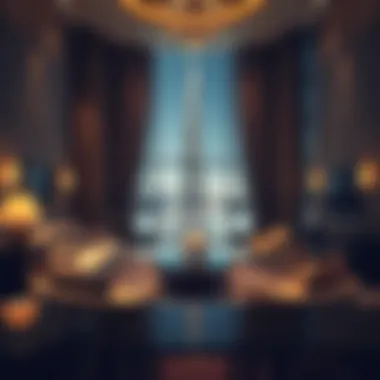

Local enterprises are also sensitive to fluctuations in the visitor economy. While some may thrive during peak seasons, they may struggle when numbers dip, pointing to the dual nature of the Burj Khalifa’s economic impact. \n In summary, the economic impact of the Burj Khalifa is multifaceted, significantly boosting both tourism and local businesses. Its towering presence represents a unique equilibrium; it enriches the city's appeal while simultaneously influencing the dynamics of Dubai's commercial landscape. These aspects are paramount for investors and entrepreneurs hoping to harness the iconic status of the Burj Khalifa to their advantage.
Sales History of Burj Khalifa Properties
Understanding the sales history of properties in the Burj Khalifa offers significant insight into the real estate market dynamics of this architectural masterpiece. It serves not only as an indicator of market trends but also, highlights the tremendous interest and investment in high-profile properties. Investors, homeowners, and real estate agents benefit from knowing how sales have fluctuated, the notable transactions that have shaped this dynamic landscape, and what those trends reflect about the future of luxury real estate in Dubai.
Notable Transactions
When it comes to the Burj Khalifa, notable transactions speak volumes. They are not just numbers; they symbolize prestige and high-end lifestyle choices. One of the striking examples includes the sale of a penthouse on the 163rd floor, which fetched an estimated price in excess of 2 million US dollars. Such transactions often become headlines not only for their staggering price but also for what they represent in the luxury market.
Owners of units tend to boast more than just a property; they own a piece of one of the world’s most recognized and photographed skylines. Additionally, public records show that studios in the lower floors often move quickly but at significantly lower prices compared to those higher up. This indicates a clear preference among buyers for views and accessibility to luxury amenities that only a few floors can offer.
Trends over Time
Analyzing trends over time reveals much about buyer sentiment and economic factors influencing real estate. Over the past decade, property sales in the Burj Khalifa have seen both peaks and troughs. In the years following the 2008 financial crisis, global luxury property markets contracted, and the Burj Khalifa was not spared. However, it has witnessed a substantial rebound, especially in the past few years as demand for premium real estate has surged.
One noteworthy trend is the increase in international buyers, particularly from Asia and Europe, who are seeking not just investment properties but also second homes in this vibrant city.
The steady rise in property value also aligns with the overall economic boom of Dubai, leading to higher demand. The typical fluctuation in prices around events such as the Dubai Shopping Festival or Expo 2020 indicates a correlation between major events and property sales, attracting attention from global investors eager to seize opportunities.
In summary, understanding the sales history of Burj Khalifa properties is crucial for anyone looking to invest in this landmark. The notable transactions and trends over time paint a detailed picture of its unique market.
"The sales history of Burj Khalifa properties not only reveals price trends but also encapsulates the pulse of luxury living in Dubai."
For additional insights on real estate trends and dynamics, consider these resources:
Knowledge in sales history empowers investors and homeowners alike with the foresight needed to navigate this remarkable landscape.
Cultural Significance
The Burj Khalifa stands not just as a remarkable feat of engineering, but as a significant cultural artifact that embodies the dreams and aspirations of a modern city. Its towering presence contributes to the narrative of Dubai as a hub of innovation and luxury, attracting visitors and investors alike. Understanding the cultural significance of such structures goes beyond mere aesthetics—it's about the values they project and the conversations they spark.
Symbol of Innovation
From its design to its construction, the Burj Khalifa reflects a strong commitment to innovation. It showcases advanced engineering techniques, such as a cutting-edge buttressed design that utilizes a series of setbacks to create a remarkable silhouette. Each aspect of its construction was tailored to meet high standards while addressing the local climate and environmental considerations. This building is not merely a structure; it's a testament to human ingenuity. Furthermore, projects like this inspire architects and engineers globally, encouraging a mindset that anything is possible.
The innovative spirit of the Burj Khalifa encourages a dialogue around urban development and sustainability. For instance, the incorporation of energy-efficient technologies such as a high-performance facade which withstands the extreme temperatures of the region does not just save costs in the long run, but sets a precedent for future skyscrapers. The ideals represented by this landmark reverberate throughout Dubai’s development plans, shaping its identity as an innovative metropolis. This construction has pushed many individuals and organizations in the region to rethink what is possible, thereby setting a benchmark for high-rise buildings worldwide.
Global Recognition
Globally, the Burj Khalifa has become synonymous with Dubai itself. It's not just a local landmark; it’s recognized around the world as a symbol of ambition and luxury. Images of the skyscraper soaring into the sky adorn travel brochures, magazines, and news articles, often used to encapsulate the spirit of Dubai. The Burj Khalifa’s distinct profile has contributed to the branding of Dubai as a premier international destination, driving both tourism and business investment.
Countless global events have been centered around this iconic structure, including the famed New Year’s Eve fireworks display that attracts millions of spectators. This annual spectacle not only showcases the Burj Khalifa but also emphasizes its role in promoting cultural exchange. Moreover, as it features prominently in films and television shows, it has reached audiences that may never set foot in the city, further solidifying its status as a globally recognized symbol.
In summary, the cultural significance of the Burj Khalifa contributes greatly to its identity and that of Dubai. As investors and stakeholders consider opportunities within this unique marketplace, understanding this cultural backdrop becomes essential, lending perspective to the investment landscape.
Investment Potential
Investing in the Burj Khalifa, the tallest building in the world, offers a unique proposition for both seasoned investors and those new to real estate. When one considers the sheer scale and symbolism of this architectural wonder, the potential for high returns becomes apparent. Not only does it occupy a prime segment of Dubai's property market, but it also attracts a steady influx of interest from homebuyers, expatriates, and investors from around the globe. This high level of visibility and desirability can be advantageous, notably in terms of property appreciation and rental yields.
Key factors that drive investment potential include the following:
- Location: Burj Khalifa's strategic position in downtown Dubai ensures it has proximity to major business hubs, shopping complexes, and cultural attractions. This boosts its attractiveness as a residential or commercial investment.
- Cultural and Economic Importance: As a global icon, the Burj Khalifa plays a key role in Dubai's identity and economy. Events, exhibitions, and concerts held in the vicinity contribute to sustained foot traffic, enhancing business viability in the area.
- Government Initiatives: Dubai's government has put in place policies that favor foreign investments, creating a conducive environment for securing profitable deals.
In essence, understanding the investment potential of the Burj Khalifa requires not just a look at the numbers but also an appreciation of the factors that make this landmark a worthwhile commitment for real estate ventures.
Risk Assessment
Investing in iconic landmarks like the Burj Khalifa is not without its risks. While the allure is strong, it's essential to conduct thorough due diligence before diving in. Potential investors must be mindful of the following risks:
- Market Volatility: Property prices can swing due to economic downturns or changes in regulatory frameworks. Investors must remain informed of market conditions.
- Operational Costs: Owning a property in such a prestigious locale comes with significant maintenance and management fees. These require careful budgeting to avoid financial strain.
- Dependence on Tourism: The Burj Khalifa thrives on tourism. Any declines in visitor numbers due to external factors, such as global pandemics or economic recessions, could negatively impact the profitability of investments in the area.
Long-term Viability
Considering long-term viability in investing within the Burj Khalifa should not be overlooked. Investors should think about the sustainability of their investment over time. Important aspects include:
- Infrastructure Development: Ongoing improvements in the surrounding area—like travel links and amenities—can enhance property value and desirability.
- Global Trends in Luxury Housing: Analyzing trends in high-end property investments worldwide can yield insights into the longevity of value around Burj Khalifa.
- Diverse Usage Potential: Properties in the Burj Khalifa can serve multiple purposes—residential, commercial, or even as high-end rentals. Such diversity can help buffer against market changes.
The potential of the investment and its long-term viability both hinge on an analysis that encompasses these risks and factors. Being well-informed allows investors to navigate the intricate landscape that surrounds investment in the Burj Khalifa successfully.
"Investing strategically in landmarks like the Burj Khalifa does not only mean focusing on immediate financial gains, but also understanding their long-term sustainability and impacts on the broader market."
For further exploration of property investment in Dubai, consider resources on Britannica and Wikipedia to gain more foundational insights into real estate in this flourishing city.
Comparison with Other Global Landmarks
When discussing the Burj Khalifa, it is essential to place it in the context of other global landmarks. This approach offers insights into why it stands out—not just as a towering structure but as a significant investment and a tourist magnet. Comparing its costs, features, and investment potential with other famous buildings can provide valuable perspective, especially for investors, homeowners, and real estate agents who may be contemplating properties in or around such iconic locations.
Cost per Square Foot
The cost per square foot is a critical metric in real estate. It sets the expectation for investors by providing a straightforward way to gauge value. For Burj Khalifa, the cost per square foot is notably high, reflecting the luxury and premium attributes associated with the property. When you start to look at other landmarks, like One World Trade Center in New York or the Shard in London, you find that the Burj Khalifa often carries a higher price tag. This is due to its exclusive features and amenities that cater to an elite clientele.
Prices fluctuate based on various factors, yet as of late 2023, reports indicate that luxury units in Burj Khalifa could reach upwards of $3,000 per square foot, contrasting sharply with the approximate $1,500 per square foot for a similar luxury apartment in One World Trade Center. This expanded price difference not only showcases the demand and exclusivity but also raises questions regarding future market trends and valuations.
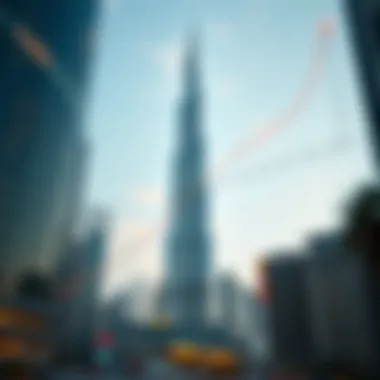
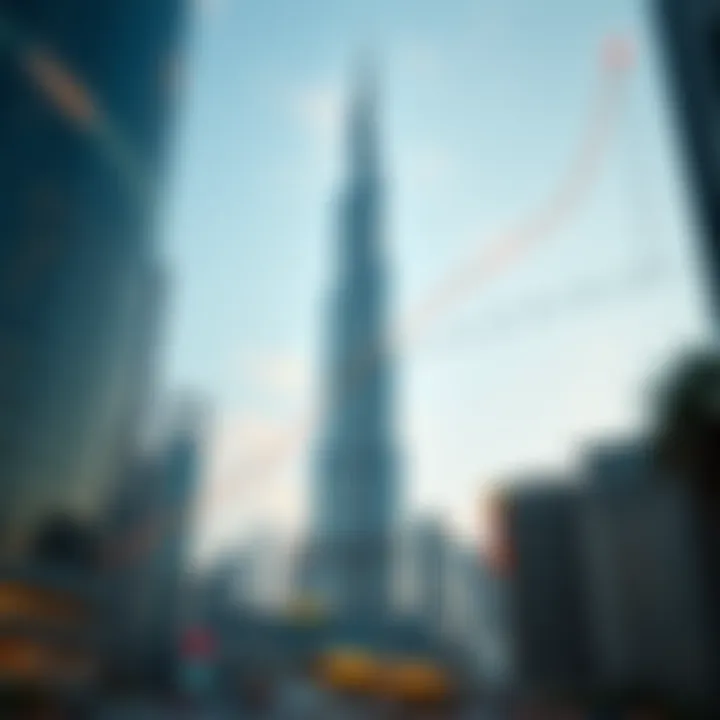
Amenities and Luxury offered
Burj Khalifa is not just a building; it's an experience. The amenities provided within the tower are nothing short of exceptional, making it a desirable choice for high-end leasing or buying. Residents enjoy access to a variety of luxury services, including:
- Infinity Pool: Set on the 76th floor, it's not just about a swim but about unparalleled views of the Dubai skyline.
- Spa Services: Top-notch relaxation and wellness facilities ensure a luxurious lifestyle.
- Observation Deck: At the 148th floor, the observation deck offers stunning panoramic views, attracting tourists while also adding to the value for owners.
- Fine Dining Restaurants: Options for high-end cuisine provided amidst breathtaking scenery.
Comparatively, other global landmarks might offer singular facilities or amenities, but few can match the collective suite found within the Burj Khalifa. Consequently, these offerings significantly influence potential market value and buyer interest, making Burj Khalifa not just a place of residence, but an emblem of opulence and luxury.
"Investing in Burj Khalifa properties is not merely about buying a home; it's about owning a piece of history, wrapped in luxury and exclusivity."
Future of Burj Khalifa Prices
Exploring the future pricing landscape of the Burj Khalifa is crucial not just for investors but also for homeowners, agents, and developers alike. As one of the most recognizable landmarks globally, the Burj Khalifa represents more than just a stunning architectural feat; it encapsulates an array of economic potentials and investment opportunities. The significance of understanding future price trends cannot be overstated, particularly given the rapid evolution in property markets influenced by various factors, such as changing consumer preferences, global economic shifts, and even tourism dynamics.
As the skyline of Dubai continues to evolve, the implications for Burj Khalifa pricing are multifaceted. Analyzing these upcoming trends promises strategic insights for prospective buyers and investors, helping them gauge whether investing in this iconic structure aligns with their long-term goals.
Predictions and Market Analysis
Market predictions for the Burj Khalifa prices offer a glimpse into potential fluctuations shaped by diverse forces. Economic analysts often delve into several key indicators when forecasting property prices, and the Burj Khalifa is no exception.
- Tourism Recovery: Given its status, the Burj Khalifa heavily relies on tourism. A resurgence in travel post-pandemic can significantly boost occupancy rates in its residential and commercial properties, affecting demand and pricing.
- Regulatory Environment: Changes in local regulations regarding foreign investments can play a pivotal role. For instance, easing laws may invite more foreign investors which could inflate property prices.
- Economic Conditions: If Dubai's economy remains robust with growth in various sectors, we might see consistent upward pressure on property prices within the Burj Khalifa and surrounding areas.
- Supply and Demand Dynamics: Monitoring new property developments in around the Burj Khalifa is necessary, as increased supply can dilute prices. Conversely, if demand outstrips supply due to its iconic status, expect rising prices.
"Understanding the trajectory of property trends at the Burj Khalifa is not just about historical data; it's about navigating the future landscape of Dubai’s real estate market."
Emerging Trends to Watch
Staying ahead of the curve means keeping an eye on the emerging trends which could influence the future price of Burj Khalifa properties. Here are some crucial points to consider:
- Sustainability Initiatives: With an increasing focus on sustainability, properties that integrate green technology and infrastructure may fetch higher prices. The Burj Khalifa is situated at the forefront of this trend, as its architects are known to prioritize eco-friendly designs.
- Smart Home Technology: The incorporation of smart technologies in residential units is becoming a standard expectation. Buyers may lean towards properties within the Burj Khalifa equipped with modern smart home features, potentially raising their value.
- Cultural Events and Activities: Hosting key cultural events and international conferences can elevate interest in the property, thus influencing pricing. The UAE's continued investment in culture could be a boon for Burj Khalifa's market position.
- Luxury Lifestyle Preferences: As the definition of luxury evolves, investors may become more discerning. The Burj Khalifa, with its luxurious offerings, must adapt to keep attracting high-net-worth individuals while embodying aspirational living.
Overall, the interplay of these factors will shape the future of pricing for Burj Khalifa properties. By staying informed and engaged with market movements, stakeholders can make sound decisions that align with their financial aspirations.
Challenges Facing Property Owners
The allure of owning property in the Burj Khalifa is undeniable, yet it is accompanied by a unique set of challenges that potential property owners must navigate. Understanding these challenges can provide invaluable insights for investors, homeowners, real estate agents, and developers, ensuring that they are well-prepared to face the complexities of managing a space within such an iconic structure. This section aims to shed light on two significant hurdles: maintenance costs and market fluctuations.
Maintenance Costs
Owning a piece of real estate in the Burj Khalifa doesn't come cheap, especially when you consider the ongoing maintenance costs. Maintaining a structure that scrapes the sky requires a meticulous approach and significant resources.
Some key factors influencing maintenance expenses include:
- Regular Upkeep: Buildings of this magnitude demand frequent inspections and upkeep. This involves everything from cleaning glass exteriors to ensuring elevators are fully operational, which can quickly add up.
- Utility Expenses: The size and technology employed in the Burj Khalifa contribute to high utility bills. Energy consumption, water usage, and other services are more pronounced in taller buildings.
- Specialized Services: The need for specialized maintenance teams can't be overstated. Uniquely designed structures like this involve trained professionals, which leads to increased labor costs.
Market Fluctuations
While the skyline of Dubai might seem eternal, fluctuations within the property market can introduce instability that property owners must address. Being informed about the factors influencing market fluctuations is crucial for anyone involved in real estate here.
Consider the following elements:
- Economic Conditions: Global economic trends play an important role in property values. During economic downturns, property prices can drop, making restrictions more intense for owners in the Burj Khalifa.
- Supply and Demand: The balance of property availability in Dubai influences prices. If too many units become available, it could drive prices down and make it harder for property owners to rent or sell.
- Regulatory Changes: New laws or changes to existing regulations can impact the real estate sector. Owners must stay updated to understand how such shifts might affect their investments.
Regulatory Considerations
Understanding the regulatory landscape surrounding the Burj Khalifa is essential for anyone interested in the real estate market of Dubai, especially potential investors and property owners. Regulatory considerations provide a framework that dictates the rules and standards for property ownership, development, and investment. The implications of these regulations can keep property owners in good standing while ensuring investment safety. Let's dive into some specifics.
Local Real Estate Laws
Local real estate laws in Dubai have been crafted to foster a transparent and efficient property market. The laws govern everything from property zoning to title deeds. A potential buyer should be familiar with key aspects, including:
- Property Ownership Rules: Certain areas in Dubai allow for 100% foreign ownership, while other areas may restrict ownership to UAE nationals or limit the percentage of foreign holdings.
- Rental Regulations: Understanding the rental market and the tenancy laws can safeguard both landlords and tenants. Laws specify tenant rights, the process for evictions, and how lease agreements must be structured. Familiarity with these can prevent disputes.
- Property Registration: Buyers must ensure properties are registered with the Land Department, which provides legal recognition and protects ownership rights.
Engaging with local legal expertise is paramount. Laws can be intricate, and remaining compliant can save investors from unpleasant surprises in the form of fines or legal action.
Foreign Investment Guidelines
Foreign investment in Dubai's property market can be quite attractive, but it is underpinned by specific guidelines. These regulations can dictate how foreign nationals can engage with real estate, impacting their investment decisions. Key guidelines to consider include:
- Minimum Investment Requirement: Some areas may have minimum investment thresholds, impacting how much foreign investors may need to commit before they can purchase property. This varies depending on location and type of property.
- Visa Restrictions: Owning a property in Dubai can provide eligibility for a residence visa, adding value to the investment. However, rules can differ based on the property's price and ownership structure.
- Restricted Areas: Knowledge of specific areas where foreign ownership is limited or prohibited is vital. Not all developments allow for foreign buyers, and regulations can change rapidly.
Overall, staying abreast of these guidelines and consulting local experts can make navigating Dubai's real estate market smoother for foreign investors.
"Navigating real estate laws in Dubai is tantamount to charting a course through a labyrinth—possessing a map ensures you won't lose your way."
The dynamic regulatory environment surrounding the Burj Khalifa and the greater Dubai area can offer lucrative prospects, but also presents challenges that require savvy navigation. Investors who understand local real estate laws and foreign investment guidelines can better position themselves for success in this monumental market.
Endings and Recommendations
In wrapping up an extensive exploration of the costs and values associated with the Burj Khalifa, we find ourselves considering several essential points. The sheer scale of investment reflected in its construction, coupled with the ongoing implications for property owners and investors alike, underscores the necessity for a nuanced understanding of this architectural marvel.
Summary of Key Findings
- Construction Costs and Funding: The financial commitments made during the Burj Khalifa’s construction represent a multifaceted investment model, which was facilitated through a mix of local and international funding sources. Over $1.5 billion USD went into its development, a figure that is astonishing when dissected against the backdrop of real estate in Dubai.
- Current Market Value and Economic Impact: The evolving market for both residential and commercial spaces within Burj Khalifa illustrates a solid potential for growth. Properties have seen a sizeable appreciation over the years; and the building continues to attract luxury buyers and tenants, which is a clear indicator of strong demand.
- Cultural and Global Significance: More than just a physical structure, the Burj Khalifa stands as a symbol of modern engineering and a beacon for tourism. It bolsters local business while holding great significance for foreign investments, making it an attractive proposition regardless of economic fluctuations.
- Investment Potential and Risks: While purchasing space in the Burj Khalifa does entail considerable risk—particularly concerning market stability—its long-term viability appears promising. Strategic approaches to acquisition can mitigate risks and alert potential investors to viable opportunities.
"The Burj Khalifa is not merely a building; it's a testament to ambition and a reflection of economic potential in a unique market."
Guidance for Prospective Buyers
For those contemplating investment in properties within the Burj Khalifa, careful consideration of several factors is imperative:
- Market Trends: Keeping an eye on real estate trends is essential. Understanding when to buy versus when to hold can significantly impact returns on investment.
- Regulatory Environment: Familiarity with local laws and potential hurdles for foreign investors will prepare buyers for any unexpected challenges and help ensure compliance.
- Financial Overview: Analyzing the total cost of ownership, including maintenance and service fees, enables a holistic view of the financial commitment.
- Consulting Experts: Engaging with real estate professionals who specialize in Dubai’s luxury market can provide tailored insights and guidance, streamlining the decision-making process.
The final takeaway here is that the Burj Khalifa represents not just a piece of real estate, but rather an opportunity interwoven with risks and rewards. Investors need to weigh these considerations carefully before diving in. Only then might they unlock the true potential that lies within this extraordinary structure.







